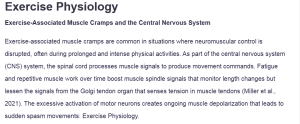Exercise Physiology
Exercise-Associated Muscle Cramps and the Central Nervous System
Exercise-associated muscle cramps are common in situations where neuromuscular control is disrupted, often during prolonged and intense physical activities. As part of the central nervous system (CNS) system, the spinal cord processes muscle signals to produce movement commands. Fatigue and repetitive muscle work over time boost muscle spindle signals that monitor length changes but lessen the signals from the Golgi tendon organ that senses tension in muscle tendons (Miller et al., 2021). The excessive activation of motor neurons creates ongoing muscle depolarization that leads to sudden spasm movements: Exercise Physiology.
The Role of the Golgi Tendon Organ (GTO)
The GTO is a proprioceptive receptor in tendons near the muscle-tendon junction that is involved in the monitoring and regulation of muscle tone. Its primary function is to inhibit excessive force production by reducing the activity of motor neurons, thereby protecting muscles and tendons from injury. During intense or prolonged muscle contractions, however, the inhibitory response from the GTO diminishes, allowing unchecked motor neuron firing and sustained muscle contractions (Oliver et al., 2021). The lower feedback signal from muscles lead to development of cramps as a result of neuromuscular disturbances in EAMCs.
Practical Applications and Recommendations
Immediate relief for frequent cramp sufferers can be passively stretching, which decreases the excitability of motor neurons through the activation of inhibitory interneurons. The long-term approaches include strength and flexibility training, adequate hydration strategies, and electrolyte supplementation to avoid neuromuscular imbalances (Martín-Rodríguez et al., 2024). A gradual increase in both exercise intensity and duration will further help minimize the onset of fatigue and its associated heightened excitability.
Age and Ability Considerations
For older adults, treatments should focus on moderate activities and nutrition that can help counteract neuromuscular aging. Sports training combined with recovery tools such as massage and compression works well for healthy and active young individuals (World Health Organization, 2020). Age and physical capability levels should guide the design of prevention and treatment practices for EAMCs.
References
Martín-Rodríguez, A., Belinchón-deMiguel, P., Rubio-Zarapuz, A., Tornero-Aguilera, J. F., Martínez-Guardado, I., Villanueva-Tobaldo, C. V., & Clemente-Suárez, V. J. (2024). Advances in understanding the interplay between dietary practices, body composition, and sports performance in athletes. Nutrients, 16(4), 571. https://doi.org/10.3390/nu16040571
Miller, K. C., McDermott, B. P., Yeargin, S. W., Fiol, A., & Schwellnus, M. P. (2021). An evidence-based review of the pathophysiology, treatment, and prevention of exercise-associated muscle cramps. Journal of Athletic Training, 57(1), 5–15. https://doi.org/10.4085/1062-6050-0696.20
Oliver, K. M., Florez-Paz, D. M., Badea, T. C., Mentis, G. Z., Menon, V., & de Nooij, J. C. (2021). Molecular correlates of muscle spindle and Golgi tendon organ afferents. Nature Communications, 12(1), 1451. https://doi.org/10.1038/s41467-021-21880-3
World Health Organization. (2020). Recommendations: WHO guidelines on physical activity and sedentary behaviour. NCBI Bookshelf. https://www.ncbi.nlm.nih.gov/books/NBK566046/
ORDER A PLAGIARISM-FREE PAPER HERE
We’ll write everything from scratch
Question
03 Assignment:
- Discuss the relationship between exercise-associated muscle cramps and the central nervous system. What is happening with the spinal cord during prolonged and intense exercise that increases possibility for muscle cramps? What role does the Golgi tendon organ (GTO) play in muscle cramping?
Conclude with a practical application. How might you assist someone with a tendency for frequent muscle cramps? What would you recommend for reducing their occurrence? Would your recommendations change depending on their age or ability? If so, how?
Reading Assignment:
- Powers, S. (2023). Exercise Physiology: Theory and Application to Fitness and Performance (12th ed.). McGraw-Hill Higher Education (US). https://online.vitalsource.
com/books/9781266201882 -
-
- Chapters 6-8
-
- 11th ed
-
03 Weblinks

Exercise Physiology
- Immune and Nervous Systems, Skeletal Muscle
- National Institute of Health – A U.S. governmental organization with current research dedicated to understanding, treating, and preventing infectious, immunologic, and allergic diseases. The following link is dedicated to Immune System Research and includes studies on how the body targets invading microbes, infected cells, and tumors. According to NIH, the combination of new technology and expanded genetic information reveals how the body protects itself from disease, allowing scientists to develop new strategies for the prevention and treatment of immune-mediated diseases.
- https://www.niaid.nih.gov/
research/immune-system- research Links to an external site.
- Muscular Dystrophy Association – An organization dedicated to research, education, direct care services, and family support related to diseases that weaken and breakdown skeletal muscles.
- https://www.mda.org/ Links to an external site.
- Central Nervous System Structure and Function – Khan Academy videos introducing the nervous system.
- “Overview of Neuron Structure”
- “Overview of Neuron Function”
- “Structure of the Nervous System”
- “Functions of the Nervous System”

